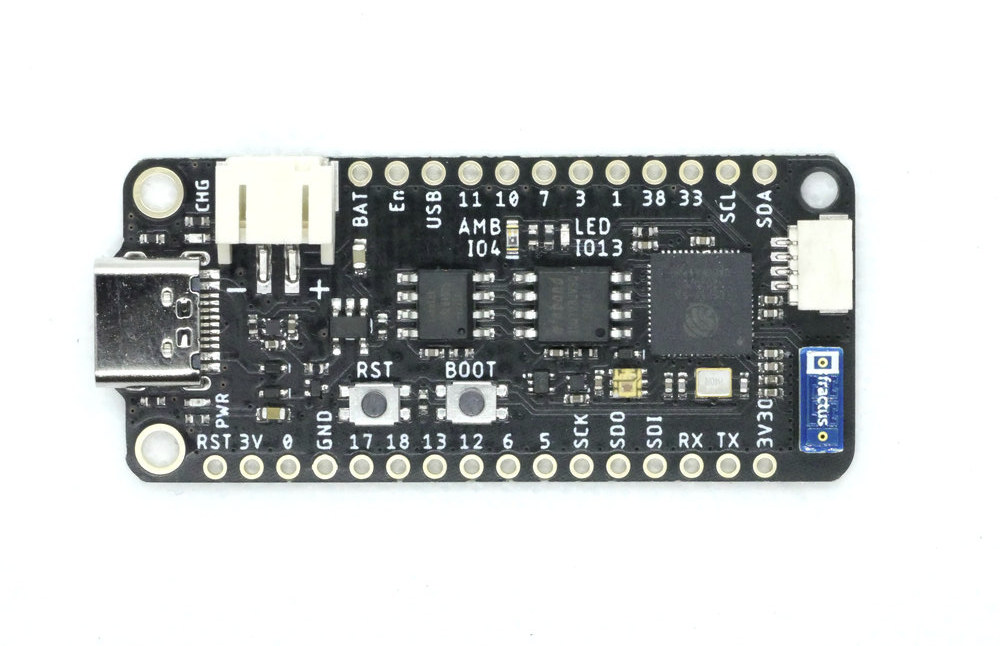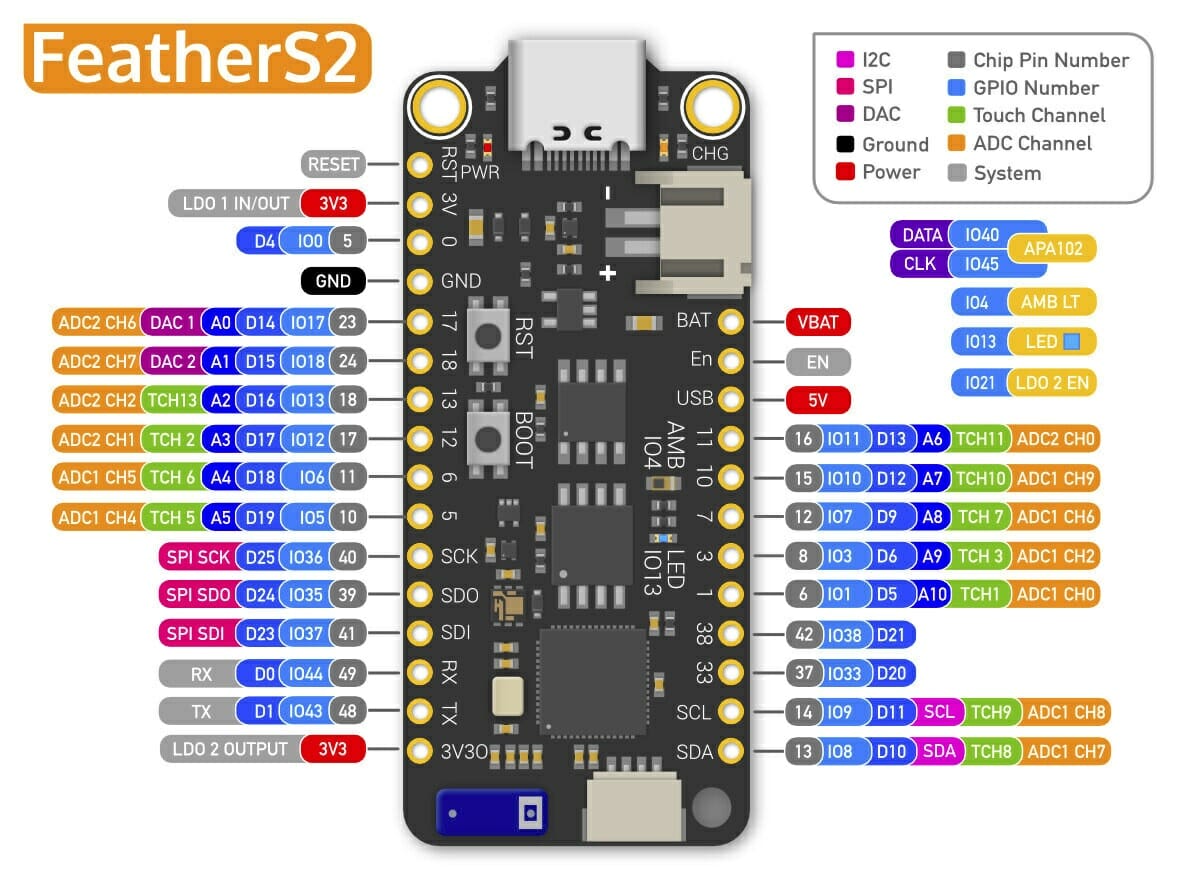We’ve covered a fair number of development boards following Adafruit Feather form factor in the last year or so with products such as QuickFeather Cortex-M4 + FPGA board, OrangeCrab (Lattice FPGA), nRF9160 Feather providing LTE IoT & GPS connectivity, and other boards.
But here’s yet another Adafruit Feather themed board that has just launched: FeatherS2. The tiny board is equipped with the latest Espressif Systems ESP32-S2 WiFi SoC, 16 MB SPI Flash, 8 MB PSRAM, several I/O, and a USB-C port for power and programming.
FeatherS2 key features and specifications:
- SoC – ESP32-S2 single-core Tensilica LX7 processor @ 240 MHz, RISC-V ultra-lower power co-processor, 320 kB SRAM, 128 kB ROM
- Memory – 8 MB extra PSRAM
- Storage – 16 MB SPI Flash
- Connectivity – 2.4 GHz Wi-Fi – 802.11b/g/n with 3D antenna
- USB – 1x USB-C port for power and programming
- Sensor – ALS-PT19 Ambient Light Sensor
- Expansion
- 16 + 12 through holes for up to 21x GPIOs, I2C, SPI, UART, DAC, touch interface, ADC, and power signals
- QWIIC/STEMMA connector
- Misc – Power, charger and user LEDs, RGB LED,
- Power Supply
- 5V via USB-C port
- 2-pin battery connector
- 2x 700 mA 3.3 V LDO regulator
- Optimized power path for low-power battery usage
- LiPo battery management
- Dimensions – Approx. 5.1 x 2.3 cm (Adafruit Feather form factor)
You may wonder why there are two LDO voltage regulators on the board. The developer, unexpected maker, explains:
The first one is for the general operation of the board and the ESP32-S2, RAM and Flash.
The second LDO is for you to use to connect external 3V3 modules, sensors and peripherals, and it has programmable EN control tied to GPIO21 + it’s connected to the deep sleep capabilities of the S2, so if the S2 goes into deep sleep, the 2nd LDO is automatically shut down for you!
FeatherS2 boards currently ships with CircuitPython 6.0 beta1, and everything has been tested and working, except for analog input support that is still under development. If you don’t feel like programming with Python, C++ is an option with early support for the ESP-IDF and Arduino code.
Unexpected Maker sells the board directly on his website for $20 plus shipping, and cheaper unit prices if you order a pack from 2 to 10 boards.

Jean-Luc started CNX Software in 2010 as a part-time endeavor, before quitting his job as a software engineering manager, and starting to write daily news, and reviews full time later in 2011.
Support CNX Software! Donate via cryptocurrencies, become a Patron on Patreon, or purchase goods on Amazon or Aliexpress






Congratulations, Seon (unexpected maker). It’s a great looking board with excellent utility thanks to its ESP32 DNA but with a lot of fresh potential waiting to be exploited by those who tap the capabilities of the RISC-V coprocessor.
Agreed. It makes me think of the arduino nano but with way more features and power. We can imagine this being used in 3D printers and laser engravers for example. The board is not cheap but it only requires to add a few wires to do many things, so that’s not bad, especially for hobbyists.
I’m not sure I get the “power path” bit… I’m pretty sure we saw a board like this a while ago with the same power path and it was just a software controllable LDO like this seems to be. Maybe I’m out of the loop but “power path” from my experience is a circuit that selects the input source i.e. USB or battery and not having a software controllable supply.
Anyhow would be nice to see something like this with a proper PMIC. The ones for wearables would be perfect I think: power path for selecting between the battery and another power source (usb, solar etc), one bulk dc-dc supply and a bunch of low noise software controllable LDOs for your sensors etc. They you get stuff like an RTC with alarms, battery alarms with an interrupt etc… Something like the AXP176 (http://www.x-powers.com/en.php/Info/product_detail/article_id/28).
The low current power path has nothing to do with the second LDO. It’s about optimising the main 5V, 3V3 and VBAT power paths for minimum current draw, especially when running off battery. My TinyPICO uses the same low current power paths and is one of the best ESP32s for battery use on the market.
For the TinyPICO I can only see a MOSFET that apparently switches the input to the main LDO when USB is connected. I’m not getting the amazing feature of that as an LDO is still an LDO.
If you look at something like the Richtek RT9525 the power path there distributes the load across the available inputs, manages disconnecting the battery when it discharges etc..
Shipping to only a few countries and the shipping cost is very high.
>Shipping to only a few countries and the shipping cost is very high.
Shipping is totally broken at the moment for everyone I think. I’ve had boards packed up and sitting on my desk for 3 or 4 months now. Sending a <50g parcel to the US from here at the moment is about $40.
From which country do you send the packages?
For <50 g you could send it as a regular unregistered mail, it should be less than 10 US$ from/to anywhere in the world…
There is no economy and untracked mail anymore… Not in Australia and at least half the world. Shipping is a nightmare now, nothing I can do about it. Also, I won’t ship a package untracked with the current state of things.
Japan. Right now to a lot of places there is no airmail for anything except normal letters. There’s no SAL service, no EMS etc. Surface mail is available but it’ll take 2 months or more.
Shipping used to be free for everything on ebay from China but now it’s at least $10 even for small items.
Those must be Breadbee boards, and that explains why the Crowdfunding campaign has not started yet…
You guess right.. I have 6 or 7 packaged on my desk waiting to go to people that offered to help out but each time I go to the post office they look at the labels and say “can’t send this, this one too… yeah this one too”.
Before I put it live there is an issue with the USB connector sometimes breaking off and potentially making the boards cheaper ($1.5 SoC vs $3.50) and all of that is delayed at the moment due to shipping etc.. but the other reason is I want to get a bit more working in mainline before going live so it doesn’t turn into a witch hunt after me for selling useless boards.
The PCB/Assembly data etc has been sitting waiting at PCBWay for a few months now.
Willy has been soldering them together himself and he wrote up a nice run down for anyone that’s interested: https://wtarreau.blogspot.com/2020/09/breadbee-build-your-own-single-board.html
Let me get this, so what new ground broken other than wifi onboard? 12 comments? sure hacker prototyper convenience, but not for the field, I agree ethernet port is tall square and downright anachronistic, this little board hasnt room, but i stress mitm attacks not gonna vanish anytime soon so why isnt there ethernet over usb-c or similar? or atleast that option?